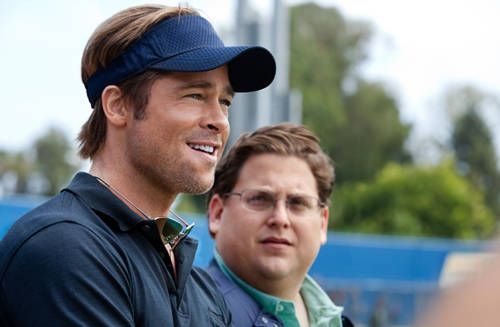'Moneyball' is Entertaining, and Not Accurate

Since I’m the co-author of a recent book critical of the book Moneyball, folks have been asking what I think about the new movie based on the book. The answer may surprise them: I liked it. What’s not to like? Brad Pitt brilliantly plays the hero in an entertaining melodrama in which the good guys best the bogeyman.
The bogeyman is the benighted baseball establishment. The good guys are Oakland A’s General Manager Billy Beane and his geeky sidekick, who recognize that the game can be revolutionized by advanced statistics. According to the film, which is reasonably faithful to the Michael Lewis book, the A’s achieved great success on a shoestring budget thanks to Beane’s revolutionary ideas that the establishment reflexively dismissed.
Great story, well acted, and I won’t be upset if the movie garners awards. I will be upset, though, if anyone thinks that the story line bears much relationship to actual events. It’s fitting that Michael Lewis’s book went Hollywood: it tells a gripping story rooted more in a writer’s fertile imagination than in reality.
As an explanation for the A’s success, Moneyball fails to survive scrutiny. For one thing, no special explanation is needed. Through conventional means, low-budget teams sometimes acquire enough quality players to succeed. During the 2002 season chronicled by Moneyball, the A’s featured three dominant starting pitchers. Advanced statistics had nothing to do with Beane’s acquisition of these stars, so what did Michael Lewis do? He treated the team’s crown jewels as an afterthought, while dwelling on two relatively inconsequential middle relief pitchers. So too, Lewis barely mentioned three sluggers (including the league’s Most Valuable Player) who combined for more than 90 home runs. They contributed mightily to Oakland’s success, but didn’t fit the book’s strained explanation for that success.
Low-budget teams are at a disadvantage. While some do well in any given season, and a few thrive for several years at a clip, teams with shallow pockets generally struggle to sustain success over the long haul. (One exception, the Minnesota Twins, has succeeded for the better part of two decades while explicitly disavowing the tactics trumpeted by Moneyball.) But Moneyball suggested that Billy Beane could overcome the obstacles and sustain Oakland’s success because of his utilization of advanced statistics. As it happens, even as Hollywood celebrates Beane, his A’s just completed their fifth consecutive mediocre (or worse) season.
Why? In part because the major insights attributed to Beane by Moneyball turned out to be bogus. Much of the book covers the 2002 draft, suggesting that Beane drafted brilliantly because of his unconventional ideas. He eschewed high school players in favor of college players, and assessed college players based wholly on statistics, especially on-base percentage (OBP), without the traditional reliance on scouts.
Michael Lewis focuses analysis of Beane’s drafting acumen on two college players: Jeremy Brown and Brant Colamarino. Both were slow, misshapen, and panned by scouts, but had great OBPs; Beane craved them. Neither player made it. (Brown retired after ten at-bats with Oakland. Colamarino never rose higher than Double A.) Indeed, of the 400 players Beane selected in his first ten drafts, roughly 5% had any impact.
All told, there is zero evidence to support one of Moneyball’s pillars: Beane’s unique ability to identify and draft undervalued prospective stars. Indeed, Beane’s weak track record drafting players clearly contributed to the team’s disastrous performance in 2011. Many low-budget teams fared better – not just this year but over the past several years.
In Lewis’s telling, the A’s use of advanced statistics also produced superior game management. The team adhered to a key tenet of the advanced statistics crowd: outs are too precious to give up with sacrifice bunts or to risk with aggressive base-running. There are various problems with this overly tidy analysis, and both pre- and post-Moneyball many teams thrived by ignoring the admonition against risky base-running. Beane himself came to see the light – his A’s have become an aggressive base-running team.
Asked about the change in tactics, Beane cites the intangible effects that mathematical formulae cannot capture. His teams take chances on the bases because of the cascading benefits of what Beane calls the “mentality of aggressiveness.” Beane deserves credit for changing course, but that doesn’t change the fact that another key insight attributed to him by Moneyball did not stand the test of time.
Anyone interested in an entertaining tale should go see Moneyball the movie. Anyone interested in a book that (in the words of former baseball commissioner Fay Vincent) “takes apart the Moneyball myths” and offers an alternative vision of baseball, should check out Shorthopsbaseballbook.com.

